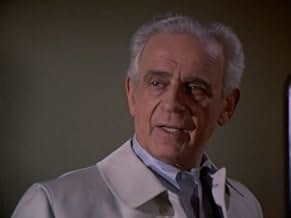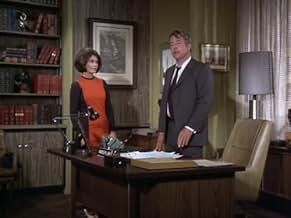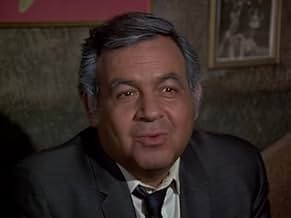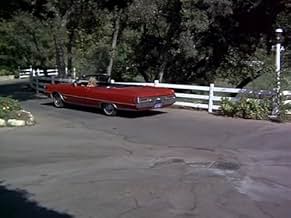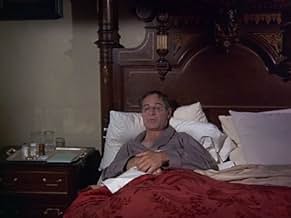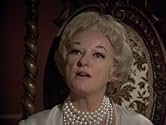Aggiungi una trama nella tua linguaRod Serling presents tales of horror illustrated in various paintings.Rod Serling presents tales of horror illustrated in various paintings.Rod Serling presents tales of horror illustrated in various paintings.
- Candidato a 2 Primetime Emmy
- 2 vittorie e 4 candidature totali
Sfoglia gli episodi
Recensioni in evidenza
Caught a few episodes of this once again, as part of a Memorial Day marathon on Encore's MYSTERY! Channel. In spite of the fact that it was mostly reviled by critics and not a few viewers, when it originally ran on NBC back in the early '70's, it now has garnered a cult following and I can definitely see why.
GALLERY in its own way, did for horror anthologies what TWILIGHT ZONE did for science fiction and fantasy. It's not as good as ZONE was in most respects, and I don't think that Rod Serling intended it to be. Free of the pressure of topping himself, which was something damn near impossible to do, GALLERY could be wildly uneven in the way the stories were featured, as it has been mentioned before, in terms of both quantity and quality. One story could take up an entire hour, while a half-hour tale could be accompanied by much shorter vignettes, some of them no more than LOVE, AMERICAN STYLE-quality blackouts, albeit it with endings that feature mayhem rather than marriage, though just as hokey.
A lot of the clothes, the special effects, the skewed photographic angles and lighting are positively outdated by today's standards, but that is a big part of the charm of revisiting a lot of the episodes, many which are all too familiar to the generation that grew up with GALLERY and its peer programs from this particular era.
Even more fascinating, however, is the chance to see movie and TV veterans rubbing elbows and sharing scenes with many "newbies," a lot of whom are established stars today, and the chance to see them cutting their teeth on '70's material is an interesting and sometimes enlightening experience. For example, one episode I viewed featured Kim Hunter, Harry Morgan and a very young Randy Quaid; another starred an up-and-coming actor named Bill Bixby, with Carol Lynley, Ned Glass and Donna Douglas (yes, as in "Ellie Mae Clampett," but without most of her corn-pone accent.)
Based on classic short stories by everyone from August Derleth and H.P. Lovecraft ("Pickman's Model"), to Charles Beaumont and Ray Bradbury, the adaptations varied in quality, but usually never suffered as much as the original stories. Even so, there were scripts, directing and acting that are still every bit as good as anything produced today, better even, since anthology shows such as this are in woefully short supply (though the revamped THE OUTER LIMITS is in reruns, and I've heard a new version of THE TWILIGHT ZONE is in the works.)
Case in point, is one of the episodes I saw in the marathon, called THE WAITING ROOM. From an original Rod Serling story, directed by one of the resident GALLERY helmers, Jeannot Szwarc, this was a masterfully dark Old West tale with a twist, and a Who's-Who of a cast that would put any character actor buff or fan of Western potboilers into High Noon Heaven: Steve Forrest, Buddy Ebsen, Lex Barker, Albert Salmi, Jim Davis and Gilbert Roland. This tale brought to mind a movie TNT did not so long ago called PURGATORY, but where that film needed ninety minutes, this episode delivered a similar punch in thirty.
Of course, there is the now-legendary work done in both the pilot movie and the series by some young, green, but talented kid with the unlikely last name of Spielberg, but if you should happen to catch this while channel-surfing, look beyond those prejudicial impressions, stop and give it a chance, especially if you haven't seen it in quite a while. There are plenty of misses that were made during GALLERY'S three-season run, but the hits, which can still leave trails of cranberry-sized goosebumps down the back of your spine, are definitely worth it. Don't believe me? Well, you'll know whether or not NIGHT GALLERY can still have an effect on you, if you still shudder when you read my closing sentence...
"...and the FEMALE LAYS EGGS...."
GALLERY in its own way, did for horror anthologies what TWILIGHT ZONE did for science fiction and fantasy. It's not as good as ZONE was in most respects, and I don't think that Rod Serling intended it to be. Free of the pressure of topping himself, which was something damn near impossible to do, GALLERY could be wildly uneven in the way the stories were featured, as it has been mentioned before, in terms of both quantity and quality. One story could take up an entire hour, while a half-hour tale could be accompanied by much shorter vignettes, some of them no more than LOVE, AMERICAN STYLE-quality blackouts, albeit it with endings that feature mayhem rather than marriage, though just as hokey.
A lot of the clothes, the special effects, the skewed photographic angles and lighting are positively outdated by today's standards, but that is a big part of the charm of revisiting a lot of the episodes, many which are all too familiar to the generation that grew up with GALLERY and its peer programs from this particular era.
Even more fascinating, however, is the chance to see movie and TV veterans rubbing elbows and sharing scenes with many "newbies," a lot of whom are established stars today, and the chance to see them cutting their teeth on '70's material is an interesting and sometimes enlightening experience. For example, one episode I viewed featured Kim Hunter, Harry Morgan and a very young Randy Quaid; another starred an up-and-coming actor named Bill Bixby, with Carol Lynley, Ned Glass and Donna Douglas (yes, as in "Ellie Mae Clampett," but without most of her corn-pone accent.)
Based on classic short stories by everyone from August Derleth and H.P. Lovecraft ("Pickman's Model"), to Charles Beaumont and Ray Bradbury, the adaptations varied in quality, but usually never suffered as much as the original stories. Even so, there were scripts, directing and acting that are still every bit as good as anything produced today, better even, since anthology shows such as this are in woefully short supply (though the revamped THE OUTER LIMITS is in reruns, and I've heard a new version of THE TWILIGHT ZONE is in the works.)
Case in point, is one of the episodes I saw in the marathon, called THE WAITING ROOM. From an original Rod Serling story, directed by one of the resident GALLERY helmers, Jeannot Szwarc, this was a masterfully dark Old West tale with a twist, and a Who's-Who of a cast that would put any character actor buff or fan of Western potboilers into High Noon Heaven: Steve Forrest, Buddy Ebsen, Lex Barker, Albert Salmi, Jim Davis and Gilbert Roland. This tale brought to mind a movie TNT did not so long ago called PURGATORY, but where that film needed ninety minutes, this episode delivered a similar punch in thirty.
Of course, there is the now-legendary work done in both the pilot movie and the series by some young, green, but talented kid with the unlikely last name of Spielberg, but if you should happen to catch this while channel-surfing, look beyond those prejudicial impressions, stop and give it a chance, especially if you haven't seen it in quite a while. There are plenty of misses that were made during GALLERY'S three-season run, but the hits, which can still leave trails of cranberry-sized goosebumps down the back of your spine, are definitely worth it. Don't believe me? Well, you'll know whether or not NIGHT GALLERY can still have an effect on you, if you still shudder when you read my closing sentence...
"...and the FEMALE LAYS EGGS...."
10sskelton
Often lost in the shadow of Rod Serling's first series, "The Twilight Zone," "Night Gallery" was a fascinating experiment in the anthology format. Instead of one story per episode, the hour was splintered into two, three, or four different stories of varying length. Some were quite brief, lasting no more than a minute; others lasted over 40 minutes. The quality often varied, too. A few of the little vignettes were quite bad. Some stories were quite good. And on more than a few occasions, this little mini-film festival on Wednesday nights produced segments that were as good as anything else on TV at the time. Classic episodes included "They're Tearing Down Tim Riley's Bar," "Pickman's Model" (both nominated for Emmys), "The Caterpillar," "Class of '99," "Green Fingers," "The Messiah on Mott Street," "The Sins of the Fathers," "The Doll," "Cool Air," "Silent Snow, Secret Snow," "A Question of Fear," "The Little Black Bag," and "The Dead Man." Because one of these classics could often be followed or preceded by a story of lesser quality, the series got a reputation for being wildly uneven. It was universally lambasted during its network run by near-sighted critics who were thrown off by its inconsistency, and missed the quality elements: intelligent, stylish writing by Serling and others, top-notch production values (particularly in cinematography and music), and innovative directorial touches. For its syndication run, the series segments were butchered to fit into a half-hour time slot, some losing half their length in the editing, and is a travesty, a mere shadow of its former self. Episodes of a boring ESP potboiler, "The Sixth Sense," were annexed into the syndie package with terrible results. Stick to the uncut version.
There is something that sets Night Gallery apart from all other sci-fi/thriller TV shows. An ethereal element of mystique lurks within every episode that provides for unique entertainment. Narrated by Rod Serling, Night Gallery explores the supernatural from the context of an abstract painting--a different painting each episode. When narrating his previous series, The Twilight Zone, Serling generally manifested an air of superiority to the plot--like he had it in the palm of his hand and could control it. In Night Gallery, however, he relinquishes such control and becomes more a PART of the madness; as if the gallery is controlling HIM (it is also refreshing to finally view him in color). Night Gallery episodes are NOT concluded with a Serling anecdotal summary; instead, a shocking punch is usually delivered that the viewer is left to unravel without assistance.
The directing and editing are top notch. Scenes cascade in a swift and somewhat ambiguous fashion, and camera tricks are cleverly exploited to hold our attention--proving that today's computer graphics are not essential to exact viewer interest. Simple story lines are translated into convoluted journeys of intrigue with music and sound effects akin only to The Exorcist.
Some memorable episodes include Sally Field playing a woman with multiple personalities (this was before she played Cybil, mind you); an ostracized young girl who befriends a seaweed monster; a diner jukebox that hauntingly plays only one song; a man who has an earwig planted in his ear that creeps through his brain (and lays eggs!); and a young Clint Howard (Ron's kid brother) playing a child prodigy who foresees mankind's treacherous fate.
Of course, there are those little, campy vignettes thrown in for fun, most of which are mildly amusing. Overall, this is an exhibit you will not want to bypass!
The directing and editing are top notch. Scenes cascade in a swift and somewhat ambiguous fashion, and camera tricks are cleverly exploited to hold our attention--proving that today's computer graphics are not essential to exact viewer interest. Simple story lines are translated into convoluted journeys of intrigue with music and sound effects akin only to The Exorcist.
Some memorable episodes include Sally Field playing a woman with multiple personalities (this was before she played Cybil, mind you); an ostracized young girl who befriends a seaweed monster; a diner jukebox that hauntingly plays only one song; a man who has an earwig planted in his ear that creeps through his brain (and lays eggs!); and a young Clint Howard (Ron's kid brother) playing a child prodigy who foresees mankind's treacherous fate.
Of course, there are those little, campy vignettes thrown in for fun, most of which are mildly amusing. Overall, this is an exhibit you will not want to bypass!
One of the most underrated TV series of the 1970s, and of all time, is this terrific collection of sci-fi and horror stories, hosted by Rod Serling. Often (wrongly) compared to Serling's other series, "The Twilight Zone"...the overall mood, and purpose of this series is different. The "Zone" was a collection of morality tales, disguised as sci-fi stories. A fantastic show, without a doubt, but the "Gallery" was designed purely to shock and entertain...and it certainly succeeded in that area.
So much great talent was on display in this series. The actors, writers, directors, and musicians were almost always top-notch. Though the decision to have multiple stories within each episode, did result in some mediocre results sometimes (especially with the campy vignettes), the quality of the better segments is what most remember best.
Among some of the better segments:
"They're Tearing Down Tim Riley's Bar", with William Windom (in an awesome performance) as a has-been salesman who's beckoned by the ghosts of his past.
"The Doll", about a gruesome doll, sent to a British officer as revenge.
"The Tune in Dan's Cafe", about a haunted jukebox that plays the same song always.
"Green Fingers", with Elsa Lanchester as an elderly woman, harassed by a tycoon who wants her land, where she has an unusual knack for gardening.
So many more great ones. Some folks get turned off by the dated 1970s look to this show (the costumes, sets, bright color, excessive use of zooms/close-ups). If you can get past that aspect, and rather appreciate the show's camp value, you're sure to enjoy this unique and highly original horror series. It's a classic in my book.
So much great talent was on display in this series. The actors, writers, directors, and musicians were almost always top-notch. Though the decision to have multiple stories within each episode, did result in some mediocre results sometimes (especially with the campy vignettes), the quality of the better segments is what most remember best.
Among some of the better segments:
"They're Tearing Down Tim Riley's Bar", with William Windom (in an awesome performance) as a has-been salesman who's beckoned by the ghosts of his past.
"The Doll", about a gruesome doll, sent to a British officer as revenge.
"The Tune in Dan's Cafe", about a haunted jukebox that plays the same song always.
"Green Fingers", with Elsa Lanchester as an elderly woman, harassed by a tycoon who wants her land, where she has an unusual knack for gardening.
So many more great ones. Some folks get turned off by the dated 1970s look to this show (the costumes, sets, bright color, excessive use of zooms/close-ups). If you can get past that aspect, and rather appreciate the show's camp value, you're sure to enjoy this unique and highly original horror series. It's a classic in my book.
Rod Serlings follow up to Twilight Zone. This series originally began as a four in one alternating with three other shows and each would get one airing per month. Night Gallery was easily the best and became a weekly. While Twilight Zone dealt with Science Fiction Gallery dealt on the macabre horror side. Rod as host would introduce each story via a painting.
A few (mostly the short ones) had tongue in cheek humor. The others could be very spooky. The theme music was equally eerie. The show now airs on the Sci-Fi channel. Having watched it when it originally aired it seems that the episodes are edited here and there. Later episodes were added from another series entitled The Sixth Sense and they were not nearly as good as the Serling ones.
A few (mostly the short ones) had tongue in cheek humor. The others could be very spooky. The theme music was equally eerie. The show now airs on the Sci-Fi channel. Having watched it when it originally aired it seems that the episodes are edited here and there. Later episodes were added from another series entitled The Sixth Sense and they were not nearly as good as the Serling ones.
Lo sapevi?
- QuizArtist Thomas J. Wright painted all of the paintings used to introduce each story.
- Citazioni
Rod Serling: For those of you who've never met me, you might call me the under-nourished Alfred Hitchcock.
- Versioni alternativeMajor changes were made to most episodes for syndication. The 60-minute episodes were edited down to 30 minute packages, with major edits to some of the 30-40 minute segments of the original shows. In cases of segments that were only 15-20 minutes in length, these were padded out by adding stock footage, newly shot scenes, and footage from Hollywood movies such as 2002: la seconda odissea (1972) and Fahrenheit 451 (1966). Most musical cues were also replaced for syndication. In order to augment "Night Gallery"'s syndicated run, episodes of Sesto senso (1972) were edited down to 30 minutes, had new introductions by Rod Serling tacked on, and were added to the syndicated run of "Night Gallery."
- ConnessioniEdited from Four-In-One (1970)
I più visti
Accedi per valutare e creare un elenco di titoli salvati per ottenere consigli personalizzati
- How many seasons does Night Gallery have?Powered by Alexa
Dettagli
- Data di uscita
- Paese di origine
- Lingua
- Celebre anche come
- Night Gallery
- Luoghi delle riprese
- Azienda produttrice
- Vedi altri crediti dell’azienda su IMDbPro
- Tempo di esecuzione50 minuti
- Mix di suoni
- Proporzioni
- 1.33 : 1
Contribuisci a questa pagina
Suggerisci una modifica o aggiungi i contenuti mancanti

Divario superiore
By what name was Mistero in galleria (1969) officially released in India in English?
Rispondi

